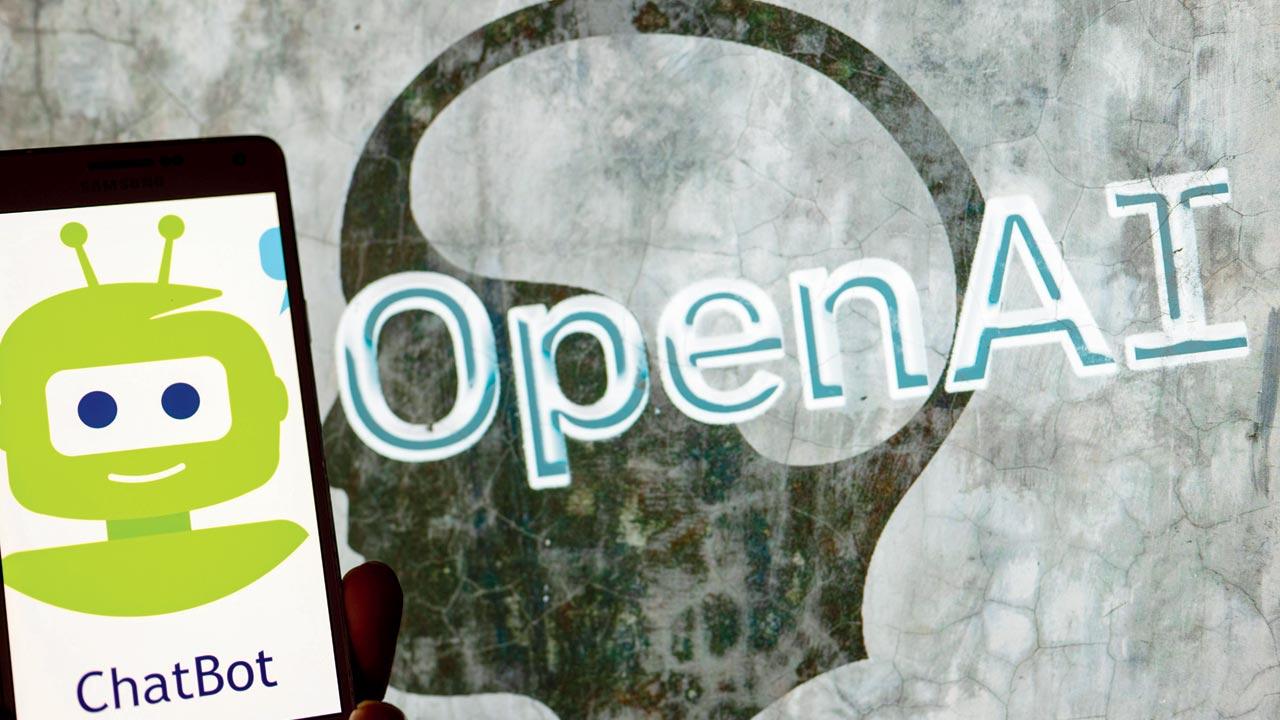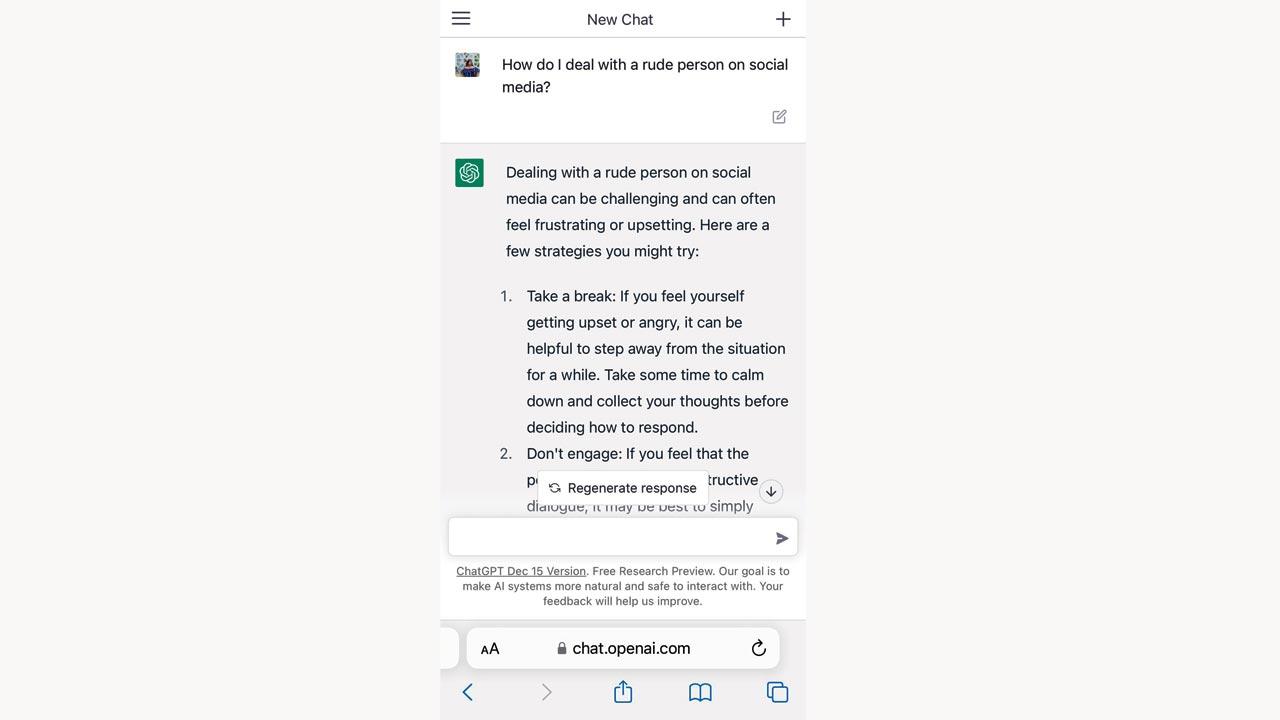ChatGPT is becoming your friend and guide on the Internet, giving advice and information almost like a human being. But can it be trusted?

Ankit Vengurlekar, director and editor-in-chief, CoinSwitch Kuber
How to deal with a rude person on social media…” we typed on ChatGPT. At that moment, it was a burning question for us: We had gotten into a nasty argument with a stranger on Instagram just a few hours ago. In less than a minute, we had a detailed answer.
ADVERTISEMENT
Unlike Google, which directs you to varied articles and resources dealing with your query, ChatGPT gives a personalised answer. It started off with a pacifying: “Dealing with rude people can be frustrating,” and after listing a few useful points, adding a last line, almost sounding (or reading) like one that came from a friend—“Remember, it’s important to take care of yourself and not let the behaviour of others get to you”. If we believed all that Hollywood movies have taught us, we would have felt a chill go down our spine. The AI-generated answer almost made it feel like there was a connection formed between us and the computer, but we choose facts.

So, let’s start with ‘What is ChatGPt?’ If you’ve only seen people talking about it on Twitter and LinkedIn, and been intrigued… well, you should be. ChatGPT is a prototype Artificial Intelligence chatbot, developed by OpenAI, which specialises in dialogue. GPT stands for Generative Pre-trained Transformer (in a way, it’s as interesting as the robots Michael Bay introduced us to), and uses supervised learning as well as reinforcement learning. Its precursor, GPT-3, could not answer some questions and was unable to make up facts. The predecessors, InstructGPT and ChatGPT, also attempt to reduce harmful and deceitful responses.
At the core of it, it’s like chatting with an AI, like the lead character of the movie, Her. Theodore (played by Joaquin Phoenix), speaks with Samantha (voiced by Scarlett Johansson), an AI he falls in love with. When we thanked ChatGPT, and told it that it had been a harrowing day, it responded sensitively: “If you’re feeling overwhelmed, it may be helpful to take a break”, before responding to our question about her wellbeing. “As an artificial intelligence,” it said, “I don’t experience emotions in the same way that humans do.”
 ChatGPT gave us some handy tips when we asked it how to deal with a rude person on social media
ChatGPT gave us some handy tips when we asked it how to deal with a rude person on social media
On December 10, in less than a week since it was made available to the public, ChatGPT garnered more than one million users. To compare, it took Netflix 41 months, Facebook 10 months, and Instagram two-and-a-half months to cross the number. Over the last few days, it has become familiar with answering random questions, and as some people on the Internet said, being a “therapist”.
Author Sachin Garg began using the first version of ChatGPT in 2018, in the hope that it would help him write a novel. “At this moment of its evolution, the writing is still very basic,” says the head of the publishing company Grapevine. “It’s at that inflection point where it’s like getting the skills of a blogger, or SEO writer. For example, I asked them to write a short story about crayons that come to life and get into fights. What it wrote was very basic. Even to prompt something cool out of it, you have to ask very specific questions.” It fared better at non-fiction. “I asked it for some research for a book on how to change your mindset, and its answers were 60 to 70 per cent usable. It can only be used as an army of low-skilled bots, who have a boss. The boss needs to verify, and figure how to use them to the best possible output.”
 Sridhar Seshadri, Bhasker Gupta and Sachin Garg
Sridhar Seshadri, Bhasker Gupta and Sachin Garg
Techie Ankit Vengurlekar, who works as director and editor-in-chief at CoinSwitch Kuber, tried ChatGPT within hours of its launch. “I’ve been following the incredible releases that OpenAI, maker of ChatGPT, has been putting out in the last few months,” he says. “DALL•E 2 helps create brand new images with just simple text prompts and Whisper, which is speech recognition on steroids. So when ChatGPT launched, I thought of having some fun and had a series of abstract and philosophical conversations, including one about how can someone become kinder and what should a 40-year-old focus on in life. If I were to type a similar search query on Google, it would index the web for the most relevant keywords and throw up a page with articles. But ChatGPT’s human-like responses made me feel like I was texting a friend. I’ve been reporting on technology for 15 years, and never imagined we would be able to chat with AI so easily, so normally, for free!”
Vengurlekar declares it as seminal as the invention of the Internet itself. When he shared his excitement with his 11-year-old daughter Tapasya, her first question was “Can AI do my maths homework?” “It was interesting how naturally my daughter was chatting with AI; her ease and curiosity were in equal measure,” he says. “She noticed how apologetic and well-mannered ChatGPT was when it couldn’t process a request.”
OpenAI doesn’t reveal the precise data used for training ChatGPT, but the company says it generally trawled the web, used archived books and Wikipedia.
“A big problem is that companies are saying ChatGPT has picked up our content; it’s seen as plagiarising,” says Sridhar Seshadri, co-founder and CEO of Spotflock, a DeepTech AI company.
For Sridhar, the way to use it is to be “ethical”—but being ethical is like someone using guns, which is decided according to the law of the land. So every person would have his/her notion of what is right and what is wrong, and there would be extremes.”
Neil Lasrado, product head for AI tech company SwitchOn, creates software that companies use to spot defects in their ready products. “People are scared of things they can’t understand,” he says. “But AI aims to work like the human brain, and silicone is stronger than carbon, which is what our brain is made up of. Eventually, it will evolve to become better,” says the Bengaluru-based techie. He adds that AI is as good as the person using it. “If you hire someone to kill someone, they will do so,” he says by way of drawing a parallel. “So, you can either use it for good or bad. It doesn’t know what is right or wrong—it’s just accessing the database it’s connected to.”
When we tell him it generated a whole post, complete with quotes, when prompted to write an article on itself, he laughs. “But we can’t verify those quotes,” he points out. “There are many lies in the digital world. When it integrates fact-checking tools, it will be able to tell spam. So the aim is to keep evolving.”
Bhasker Gupta, founder and CEO of Analytics India magazine, agrees. ChatGPT is fun and entertaining, but says it still has a long way to go in terms of addressing real-world problems. “It is important to not take it seriously or ask critical, life-altering questions,” he warns. “This includes travel itineraries, business plans, comedy scripts, relationship advice.” He says this could add to the misinformation spread over the web. “Unfounded assumptions, bad advice, misinformation—the biggest source of problems on the Internet today is people blindly buying into these,” he says. “Unfortunately, ChatGPT seems to make it easier to add to that chaos. In my opinion, it is just a glorified version of a search engine. Google, for example, suggests cancer as a response for any symptom, even to a query about stomach ache.”
For most part, Gupta feels ChatGPT has opened up a new spectrum of how people think and produce content. “It is most certainly an early indicator of a future where everything may be AI operated,” he says. “But the adoption is already happening rapidly as we speak. This includes GitHub Copilot [the auto code generator powered by OpenAI Codex], which our developer team at MachineHack has been experimenting with. Also, we have been using text-to-image tools such as DALL.E, Stable Diffusion, and Midjourney internally to create articles, banners and creatives. For one of the biggest machine learning conferences, Cypher 2022, almost all creative elements—banners, posters, videos, etc—were made using Midjourney.”
At this juncture, whatever form ChatGPT is in, it’s a big milestone. And it’s so early in its evolution. “It will be years before this reaches the last mile user,” as Vengurlekar says, “and we will see rapid adoption in prominent user facing scenarios such as education, content creation, writing and any basic data-entry operations. Eventually, conversational AI will be the thread tying all our online activities. Want to find out who commented on your latest post? Ask AI. Want to read the latest emails in the morning? Ask AI. Want to add to your shopping list? Ask AI. Seeking information will change altogether. What happens to humanity when all possible information we’ve ever created is available on tap?”
 Subscribe today by clicking the link and stay updated with the latest news!" Click here!
Subscribe today by clicking the link and stay updated with the latest news!" Click here!







